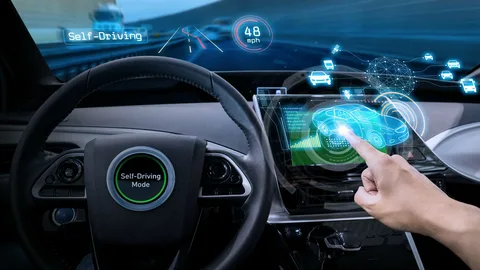From Mobility to Wellness: The Evolution of Automotive Health Tech

Introduction
The US Automotive Active Health Monitoring System Market is rapidly advancing as the automotive industry integrates health and safety technologies into connected vehicles. These systems monitor drivers’ vital signs—such as heart rate, stress levels, fatigue, and oxygen saturation—through sensors embedded in seats, steering wheels, and wearable devices. The goal is to enhance driver well-being, reduce road accidents, and create safer mobility ecosystems. With rising concerns over driver fatigue, cardiovascular risks, and distracted driving, automakers and tech companies are investing heavily in AI-driven health analytics and real-time monitoring. As the U.S. pushes toward intelligent transportation and autonomous vehicles, active health monitoring is emerging as a critical innovation shaping the next phase of automotive safety and personalized mobility.
Market Drivers
The growing emphasis on road safety and health-conscious driving is one of the major drivers of this market. The National Highway Traffic Safety Administration (NHTSA) estimates that driver fatigue and medical emergencies contribute significantly to traffic accidents each year. Active health monitoring systems address these concerns by enabling early detection of health anomalies and triggering automatic safety responses such as vehicle slowdown or emergency alerts. Another strong driver is the integration of wearable technologies and IoT-based connectivity that allows real-time data synchronization with medical and emergency services. Increasing consumer preference for premium, tech-enhanced vehicles is also propelling adoption, as automakers position health monitoring as a differentiator in high-end and electric vehicle models.
Market Challenges
Despite the growing interest, several challenges limit widespread adoption. Privacy concerns related to biometric data collection and storage remain a significant barrier, as consumers worry about unauthorized access or misuse of health information. Additionally, the accuracy and reliability of sensors can be influenced by external factors like temperature, vibration, and driving conditions. The cost of developing and integrating advanced biometric systems can also increase vehicle prices, restricting market penetration in budget and mid-range segments. Regulatory uncertainty regarding data ownership and interoperability with healthcare systems further complicates deployment. Automakers and technology partners must work together to establish trust, ensure data protection, and balance innovation with ethical responsibility.
Market Opportunities
The US automotive active health monitoring market presents significant opportunities through AI integration, connected health platforms, and the rise of autonomous driving technologies. The expansion of electric and smart vehicles provides a fertile ground for embedding biometric systems into digital dashboards and steering components. Partnerships between automotive OEMs, healthcare providers, and tech firms like Apple, Google, and Qualcomm are driving innovation in non-invasive monitoring technologies. The ability to integrate these systems with telemedicine services and health insurance platforms opens new value chains. Furthermore, advancements in predictive analytics can transform vehicles into proactive wellness environments capable of alerting drivers to potential health risks before emergencies occur, redefining mobility as both safe and health-centric.
Regional Insights
The United States is witnessing rapid development in automotive health monitoring technologies, primarily driven by leading OEMs, tech innovators, and government safety initiatives. States like California and Michigan, hubs for electric and autonomous vehicle research, are leading in deploying AI-based health monitoring systems. The southern and midwestern regions, with high commercial and personal vehicle usage, are also showing increasing demand as awareness of driver wellness grows. Moreover, regulatory support for advanced driver assistance systems (ADAS) and telematics in states such as Texas and Florida encourages the adoption of integrated health monitoring technologies. The concentration of healthcare technology companies and start-ups in regions like Silicon Valley is further propelling innovation and partnerships in this domain.
Future Outlook
The future of the US Automotive Active Health Monitoring System Market lies in convergence—where mobility, health, and AI merge to deliver intelligent, personalized safety solutions. Over the next decade, vehicles will evolve into active wellness environments capable of detecting health abnormalities, preventing accidents, and supporting medical intervention in real-time. The rise of autonomous and connected cars will make these systems more accessible, turning health monitoring into a standard feature rather than a luxury. As machine learning algorithms mature, systems will gain the ability to learn driver patterns, predict fatigue or stress levels, and adjust vehicle settings to maintain alertness and comfort. This human-centric innovation will be at the heart of the next automotive revolution.
Conclusion
The US Automotive Active Health Monitoring System Market marks a pivotal shift in how vehicles interact with their occupants—transforming from machines of mobility to guardians of wellness. By integrating biosensors, AI analytics, and connected data platforms, automakers are building safer and healthier driving ecosystems. Despite challenges related to privacy, cost, and standardization, the long-term potential is immense. As vehicles become increasingly connected and autonomous, active health monitoring will not only enhance safety but also redefine driving as an experience centered on well-being, trust, and smart responsiveness across the American transportation landscape.
- Art
- Causes
- Crafts
- Dance
- Drinks
- Film
- Fitness
- Food
- Jogos
- Gardening
- Health
- Início
- Literature
- Music
- Networking
- Outro
- Party
- Religion
- Shopping
- Sports
- Theater
- Wellness



